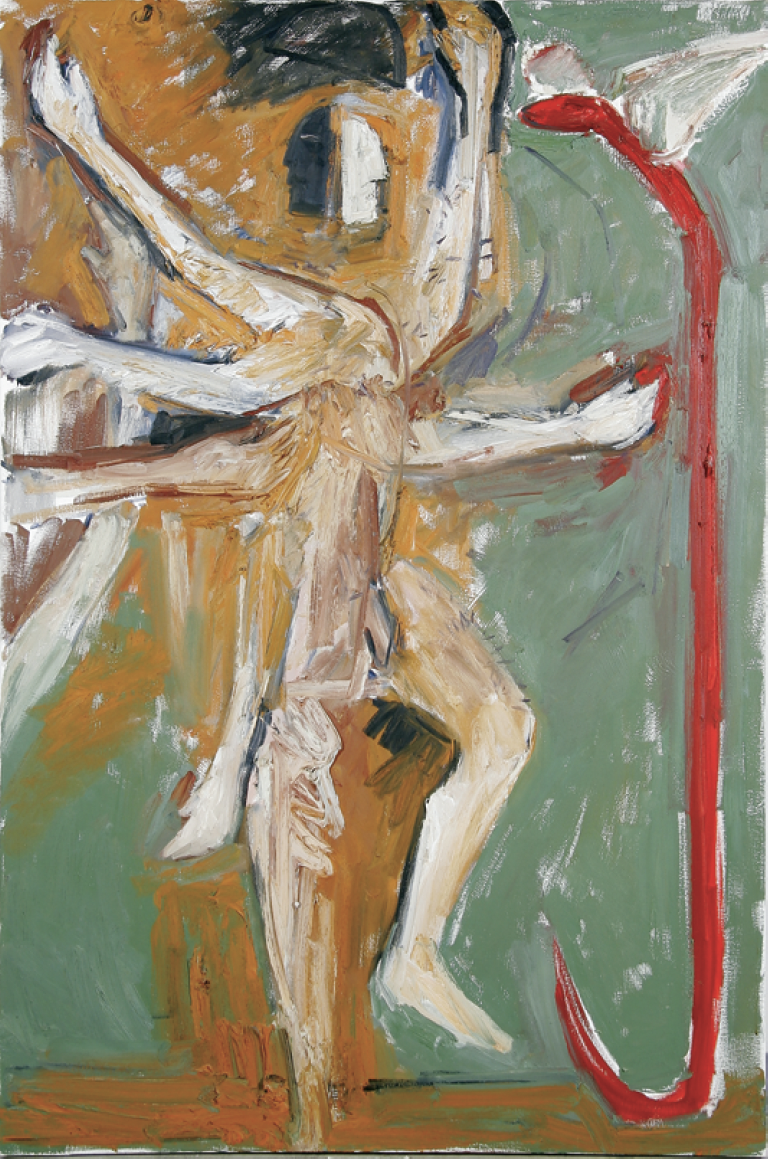Ted Fullerton
For Ted Fullerton, drawing daily is an essential and inventive tool. A question he asks throughout his working process, whether with sculpture, printmaking or painting, is how far can a gestural mark be pushed before it overpowers the subject it attempts to define? Or, put another way, where can the balance be found between materiality and image? Fullerton’s methodology challenges representation on its own terms to reveal the uncanny products of an eye turned inward. In this way, he shares with Max Beckmann, Ludwig Kirchner, Edvard Munch and Georges Rouault an honest and sometimes rambunctious sensibility towards mark-making. For these artists—and for Fullerton—a ritualistic creation process is infused with an emotional intensity that hot-wires the circuit of eye, brain and hand. The goal is to find the point at which “concept, process and materials have an affinity to an archetypal essence.” What Fullerton presents are images both strange and profound.

Ted Fullerton, Balance, 2004 (two colour). Lithograph print, 30 x 22”. Photographs: David Kerfoot, courtesy the artist and Bau Xi Gallery, Toronto.
The heart of his practice involves reformulating archetypal and mythic symbols. This reconfiguration is both skeptical and respectful of the unknowable and overwhelming nature of the subconscious. Loaded symbols that have had privileged readings are whittled down to hand-held size.
His large oil painting at the McLaren Art Centre, called Left Right Up Down (Job), 1999, depicts a topsy-turvy (male?) body with multiple arms and legs that pinwheel outward from its torso. The head is replaced by two masked profiles that face away from one another— one black, the other white. They hover against a roughened, brushy background no deeper than the span of a hand. In one way, this painting represents the Biblical Job as Shiva, a destructive and regenerative force balled into one character. It also represents a fragile, fragmented identity at the mercy of conflicting subconscious forces. The mortal and the divine are inextricably bound together in one skin, but exist at cross-purposes to one another. This is an identity in perpetual flux. Out of the once clearly defined dichotomies of male and female, the beastial and the human, the rational and the illogical, the earthbound and the celestial, Fullerton forges a momentary and unstable amalgam. He invites the viewer towards an individualized mythmaking.

Ted Fullerton, Tilted Head, 1999 (three colour, four panel). Lithograph print, 60 x 44”. Photograph: David Kerfoot.
A counterpoint to his monumental and frontal paintings is Fullerton’s prolific output of prints, shown at the Bau-Xi Gallery, which include lithographs, intaglios and woodcuts. These are informed by a fine-tuned, introspective thought process. In Balance, 2004, an androgynous face stares impassively at the viewer with the iconic simplicity of an Etruscan sculpture. Resting on top of this head is an inverted skull that has been blocked in with an economy of dark brush strokes. Surrounded by the open ground of the white paper, these mirrored entities teeter upon the most precarious pencilled-in shoulders. What results is a silent and brutal contemplation upon mortality. This lithograph is emblematic of Fullerton’s central intention, which he defines as the “reconciliation of opposites.” The dualities that have continued to occupy him over his career are here juxtaposed with virtuosic restraint and subtlety.
Fullerton’s art practice began in the ’70s centred in a naturalistic, modelled drawing style. This has given way in later years to a pared-down repertoire of spontaneous, assertive marks. Tilted Head, 1999, reveals his intention to get ideas out as urgently and succinctly as possible. For all the bravado displayed in this lithograph (the head is printed on four sheets of paper measuring over five feet tall) Fullerton’s colossus is serene and meditative. Resting in an amorphous ground, its form becomes buoyant, almost atmospheric. More symbolic than real, it begins to dissipate into something spectral. The gestural mark—the macho Expressionist signifier—is compromised by dissolved washes of litho crayon. The rhythm of action and reaction, of gesture and its seepage, represents the dubious process of dredging up symbols from the subconscious. The findings are those gleaned from attempts to recall a memory—unrelenting, fragmented and unexplainable—that refuses to be revisited the same way twice.

Ted Fullerton, Left, Right, Up, Down (Job), 1999, oil on canvas, 6 x 4’. Photograph: John Bartosik.
In an aesthetic stemming from a Romantic sensibility, the intersections of archetypes, ciphers and symbols are posed as propositions without preconceived answers. The primary intent of the work appears in the transaction among artist, object and other. Fullerton’s art offers the viewer a generous and inexhaustible potential for interpretations because media and archetypes alike are treated as analogous substances: raw materials to be compressed, remodelled, reshaped and redefined. ■
“Pushing the Edge: Selected Works in Printmaking and Sculpture” was exhibited at the Bau-Xi Gallery in Toronto from September 5 to 25, 2006; “Fallacy of the Male Construct: The Sculpture and Painting of Ted Fullerton, 1985–2005” was exhibited at the McLaren Art Centre in Barrie, Ontario, from September 14 to November 3, 2006.
Martin Golland is an artist and writer based in Toronto.

